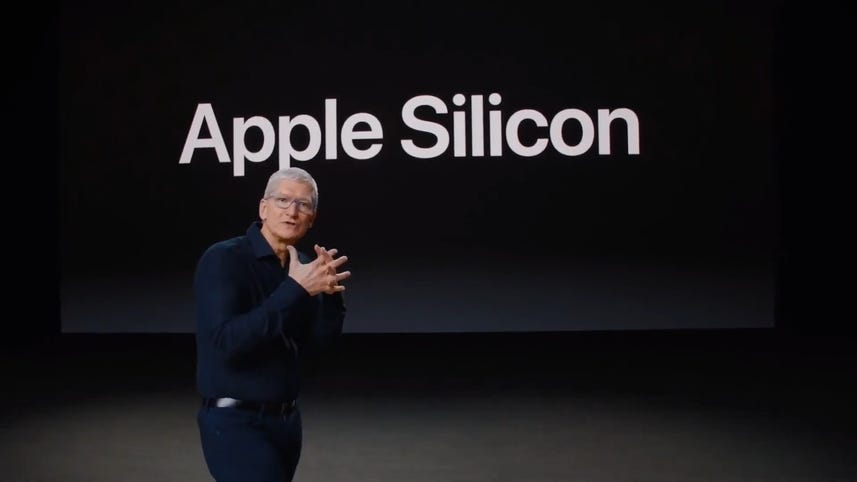
Today is the day we're announcing that the Mac is transitioning
[MUSIC]
To our own Apple silicon, when we make bold changes, it's for one simple yet powerful reason.
So, we can make much better products.
When we look ahead, we envision some amazing new products and transitioning to our own custom silicon is what will enable us to bring them to life.at Apple, integrating hardware and software is fundamental to everything we do.
That's what makes our products so great.
And silicon is at the heart of our hardware.
So having a world class silicon design team is a game changer.
To tell you more about Apple silicon, and how it will take Mac to the next level, I'd like to send you over to Johnny Sergey at one of our labs in an undisclosed location.
[MUSIC].
[SOUND].
[MUSIC]
Welcome to overlap, we've been building and refining our app in silicon for over a decade.
The result is a scalable architecture that is custom designed for Apple products and it leads the industry in features and performance per watt.
So I'd like to tell you how we got here and what it means for the Mac moving forward.
It all started with the iPhone, the iPhone demanded performance and capabilities that were seen as impossible in a device that small.
This is where we developed our relentless focus on performance per watt.
Generation after generation we push the boundaries of technology, which enable us to improve performance and energy efficiency, while building advanced and industry leading features.
Our team deliver 10 generations of increasingly complex and H designs Always improving performance.
In fact, CPU performance in the iPhone has improved by over 100 times, keeping the iPhones performance ahead of every other phone in the industry.
Another opportunity for the team was the iPad.
While iPhone chips could drive our mainstream iPads, we wanted to push the iPad even further.
It began with the iPad Retina display which demanded a custom chip.
So the team's kill our architecture and design the most optimized and highest performance chip possible for the iPad.
Starting with A5X, we built a line of SOC specifically designed for the iPad.
We debate the iPhones graphics performance to a larger GPU.
Why their memory subsystem?
This was the iPad in a class by itself.
Compared to the very first iPad, the latest iPad Pro delivers over 1000 times faster graphics performance in just 10 years.
This is part of the reason why the iPad Pro is faster than the vast majority of PC laptops.
And this foreshadows how well our architecture will scale into the Mac.
Another place where we upload our focus was to watch.
we scaled our SOC architecture to optimize performance for the device's unique low power requirements.
And we built the chip perfectly suited for Apple Watch.
Our SOC s enable each of these products with unique features and industry leading performance per watt and it makes each of them best in class.
And we do this at an enormous scale.
In fact, adding all of the processes across these three products, we've shipped over 2 billion in just 10 years.
And we've designed and shaped billions of additional chips that work together with our associates to enable our amazing products.
And now we're bringing all of that expertise and that same.
Focused and disciplined approach to the Mac.
The first thing this will do is give the market a whole new level of performance.
Now when we talk about performance, we have to talk about power because all systems built today are constrained by power consumption.
thermals are both.
Among today's consumer systems, desktops deliver the highest performance but consume the most power.
Notebooks trade of performance for lower power making them portable.
As you can see, normally to get more performance, you have to consume more power.
When you take a closer look at this chart, you realise you want to operate in the upper left corner, you want to deliver the highest performance at the lowest power consumption.
And that's exactly where we want to take demand.
Building upon our years of experience, designing the world's most energy efficient chips, our plans to give them at a much higher level of performance, while at the same time consuming less power.
So much better performance is reason enough to transition the Mac to Apple SOCs.
But that's just part of the story.
Or scalable architecture includes many custom technologies that, when integrated with our software, will bring even more innovation to the market.
With our Advanced Power Management, we will maximize performance and battery life better than ever before.
Our secure enclave will bring best in glass security.
Our high performance GPU is going to bring a whole new level of graphics performance.
To every Mac making them even better for pro applications and really grateful games, and combined with overall UI engines.
Our chips will make the Mac an amazing platform for machine learning.
And we're bringing many other custom technologies such as our video display an image processing engines, that will help make the Mac better than ever before.
So what does all of this mean for the Mac?
First, we're designing a family of SoCs specifically for the Mac product line.
Second, just like we did with the iPhone, iPad and watch.
We're going to bring great technologists to the Mac.
This will give them back a unique set of features, and incredible performance.
And third, we'll have a common architecture across all of our product lines, making it far easier for developers to write and optimize software for the entire Apple ecosystem.
Ultimately, we know that bringing our AOC to the Mac will allow us to build much better products and the Mac will take another huge leap forward.